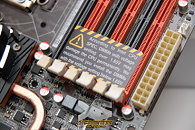Friday, October 3rd 2008

Theory of DDR3 Voltage Limitations for Bloomfield Gains Ground
Nehalem does promise to be a processor to look out for, it would be Intel's next installment, post the successful Core 2 series processors. This time however, Intel made a core modification with the way the system handles memory. The Bloomfield processors house a massive 192-bit wide memory controller for supporting tri-channel DDR3 memory. It however was found that the controller could bring in limitations to the DIMM voltages that the system could support.
The retail version of ASUS P6T Deluxe OC Palm Edition motherboard was unboxed by XFastest. Being the retail product, as usually, it comes with precautionary labels attached to parts of the motherboard. The one that covers the 6 DDR3 DIMM slots reads:
The retail version of ASUS P6T Deluxe OC Palm Edition motherboard was unboxed by XFastest. Being the retail product, as usually, it comes with precautionary labels attached to parts of the motherboard. The one that covers the 6 DDR3 DIMM slots reads:
According to Intel CPU SPEC, DIMMs with voltage setting over 1.65V may damage the CPU permanently. We recommend you to install DIMMs with voltage setting below 1.65V.It could have implications on the current DDR3 memory market as well as you, if you happen to have DDR3 modules, which you plan to retain for use in the future platform, that operate above the said voltage. It also means that in the near future, we could be seeing memory sticks that facilitate overclocking at much lower voltages. From a technology standpoint, companies such as Samsung, Elpida, Micron, etc., are working on releasing DRAM chips based on newer silicon fabrication technologies, that operate at lower voltages.

89 Comments on Theory of DDR3 Voltage Limitations for Bloomfield Gains Ground
Any standard PC1066 or PC1333 memory module needs 1.5V. (= 99% of the market)
Example:
www.ec.kingston.com/ecom/configurator_new/partsinfo.asp?root=us&LinkBack=&ktcpartno=KVR1333D3N9/2G
Why do people say stupid stuff? Nobody knows ...
the fact is nehalem operates around 1.0v and ddr3 CANNOT OPERATE AT THAT VOLTAGE.
^ PC3-10600 kits www.newegg.com/Product/ProductList.aspx?Submit=ENE&N=2010170147+1052129233+1052429248&Configurator=&Subcategory=147&description=&Ntk=&SpeTabStoreType=&Order=BESTMATCH&srchInDesc=
^The only PC3-10660 kit there
^ PC3-10666 kits www.newegg.com/Product/ProductList.aspx?Submit=ENE&N=2010170147+1052129233+1052430325&Configurator=&Subcategory=147&description=&Ntk=&SpeTabStoreType=&Order=BESTMATCH&srchInDesc=
Click on the links > advanced search > click on the "Voltage" drop-down, to see for yourself.
And please, don't call people stupid, we are t3h ov3rcl0ckers. We are worried because our overclocking gets into a mess, at least with the memory modules you get today.
@hat, i beleive its 1066, 1333 is overclocked not officially supported, correct?
Personally I think this entire increasing voltage/speed willy-nilly is not really doing us any favors. I mean why the heck should you have to go in and manually tinker with your voltage and speed settings just to get something to run as advertised? Do not get me wrong I like tinkering as much as the next girl but this has gotten to insane amounts of silly in a rather short period of time.
I guess we'll see one way or the other as time goes by and word gets out about this.
nehalem operates at ~1.0v STOCK CLOCKS
IF the ram voltage is the same 1.0v THE BOARD/RAM WONT EVEN POST
to get the ram to boot you'd have the chip pretty close to its max voltage.
to solve this memory manufactures would have to develop ddr3 that can run around 1.0-1.6v depending on clocks. that is a tall order if you ask me.
Does anyone know what's technically different in built in memory conroller in K8 / K10 ?
I mean... voltage-wise..
There are obviously some drivers that seperate CPU logic from package pins, so there is possibility to 'translate' voltage.
I don't understand why it's so limited.
Athlons can drive 2.2V DDR2 while core voltage is at 1.1V for example.
The memory controller syncing is purely only a monopolistic deterrent which Intel is using since AMD's offerings wont provide any dividends to users; i.e. AMD's proccessors are having a hard time competing. Thus Intel CAN "screw the customer over" by preventing the users from overclocking through this so-called design flaw.
Sure it might turn people away, but then again when you look back to AMD's offerings you'd probably look at the other Core 2 offerings instead.
Basically in short intel doesnt want you having as much value for money as possible; by running low end core i7 as fast as the top end one. Theres NO competition in the CPU market atm and this is one of the repercussions to the consumer.
the mem controller is in the CPU :laugh:
But i do believe, Nvidia chipset FTW.
(not that i LIKE this idea)